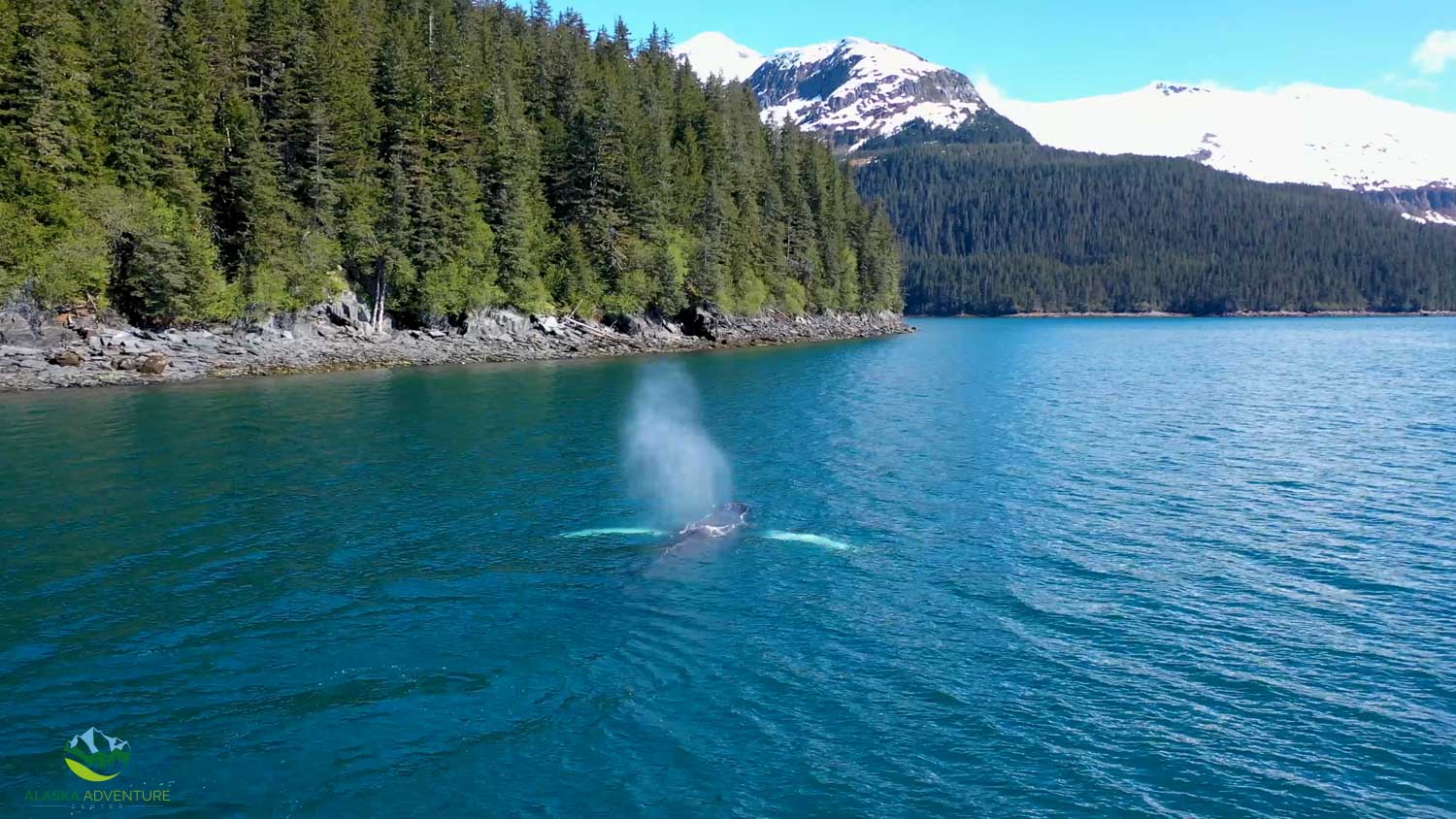Alaska Whales
Deep blue waves fill in the space between awe-inspiring views, teeming with life. These wide open worlds of water are a safe haven of strong food systems and vibrant ecology for animals to grow and thrive. Under the waves and into the depths, mammals of immense proportions sing to each other as they pirouette through the ocean. This is the world of Alaska whales.
In Alaska there are eight different species of whales. Some of the species live here year-round and others migrate to tropical regions for the winter. These whales love the abundance of food and space, primarily for feeding. Many whales use the topography of the fjords and bays to funnel and gorge on innumerable amounts of fish or krill. These colder waters make for ample feeding opportunities, encouraging healthy life cycles for whales is essential for winter breeding. Learning about these whale behaviors and identifiers could lead you to whale sightings off the shores of Alaska.
Humpback Whale
These coastal giants are a species of baleen whale. Known for their performative breaching behaviors. Humpbacks are characterized by their enormous size and melodic songs. Their rounded heads have little knob-like bumps on them and their backs are covered in a mottled black while the underneath is bright white. Some of their more famous behavior is showing off the bright white underneath their fins while slapping the water.
Humpbacks can be anywhere from 12 to 16 meters long and weigh 25-30 metric tons. When migrating, they can travel up to 16,000 miles. Their fluked tail is decorated with specific markings that are exclusive to each individual. Observing these prints is one way to identify and track these mammals. During the summer months you can spot these huge whales propelling themselves out of the water, known as breaching. In an up-close encounter you may even get a spray of fish-tinted water in a quick exhale from their blowhole.

You can spot whales from the shorelines of Homer
If you were to dive below the water you might catch a males song. These songs show repetition is tones and sounds that some believe are how they attract females, letting them know how fit they are for breeding. These songs can last anywhere from 10 to 20 minutes. Groups will sing identical songs that change with each season as the Humpback migrates to more tropical regions for the winter. During the summer months of June and July you can spot them breaching and feeding in the waters near Homer and Kodiak.
Orcas
This species is actually the largest member of the dolphin family. They navigate underwater and hunt by means of echolocation, a series of clicking indicates how far objects are away by their echoes. Some of these whales will stay year round in Alaska while others are more transient.
These mammals have complex social structures comparable to elephants and higher primates. These animals will even live with their mothers for their entire life. Groups of Orcas organize around the top female in the family. When multiple groups of families group together they are considered a pod. And, Communication occurs through underwater sound. This is used for locating food and understanding their surroundings as well.
These whales are known for their black and white print and striking triangular dorsal fin. The fear evoking name came from their behavior of eating other whales. These whales primarily feed on fish though, specifically salmon. Transient pods will hunt other marine mammals such as the sea lion. Their pods can range from 10 to 50 members, depending on how stable they are. These family groups are the most stable of any animal species. The best places to spot this whale are Resurrection Bay and the Kenai Peninsula. The window is short to see them, as they frequent the area from early May to early June.
Beluga Whales
The features of this whale are smooth and white, giving the Beluga another identifying name, a white whale. These whales are specialized to the arctic oceans. They have no dorsal fins which allows them to gracefully propel under the ice. The whales stocky body can reach up to 5.5 meters long.
Using echolocation through a variation of shrill clicking noises helps them to find food and air pockets in ice sheets for breathing. The head of this animal is bulbous, as it houses the ‘melon’, the organ that is responsible for echolocation. As the whale uses their echolocation the shape of the melon changes.
Their groups can range from two to 25 members. At times they will gather in the hundreds, or even thousands, in estuaries and in the shallows of the coast for feeding. These whales enjoy the arctic seas and move to the coastlines when it warms up in the summer. This is perfect for Alaskan sightings. These creatures are curious and will happily swim up to your boat to check you out! Your best opportunity for a sight is by the Turnagain Arm during the salmon run.
Blue Whales
Blue whales have a mottled grey color but underwater they appear blue, thus claiming their name sake. Their unique mottled patterns acts as an identification tool as well. These whales are the largest known animal on the planet and can grow to be over 30 meters long. Scientist have discovered that they can determine their age through earwax. Their earwax creates an organic ear plug that can describe, through coloration, cycles of migration and feeding and be can be counted through these layers.
Most Blue Whales can be found migrating towards tropical waters in the winter but some stick around in the higher latitudes for the whole year. Being a baleen whale, they feed on the abundance of krill along Alaska’s coast. Try your chance at spotting them in the Gulf of Alaska during July and August!

